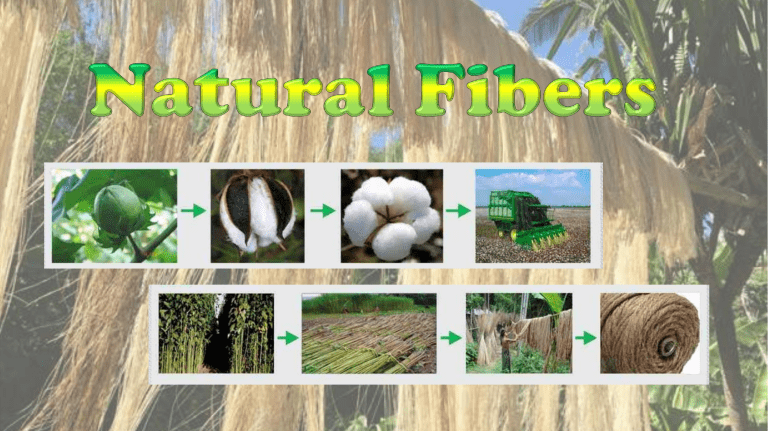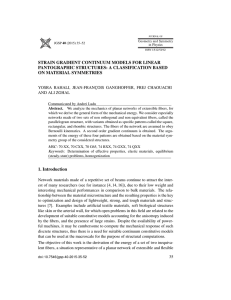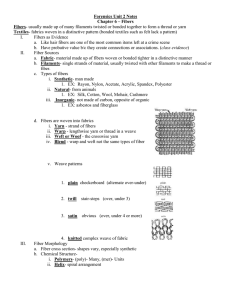
Content • Introduction • Classification of natural fibers • Properties of natural fibers • Uses of natural fibers • Advantages & dis-advantages of natural fibers • Summary • References 01 Introduction • Which are the natural fibers...? Natural fibers are defined as substances produced by plants and animals that can be spun into filament, thread or rope and further be woven, knitted, matted or bound. Natural fiber is a type of renewable sources and a new generation of reinforcements and supplements for polymer based materials. 02 Classification of natural fibers 03 • Natural fibers can be classified according to their origin. • The vegetable, or cellulose-base, class includes such important fibers as cotton, flax, and jute. The animal, or protein-base, fibers include wool, mohair, and silk. 04 Plant fibers Plant fibers include seed hairs, such as cotton; stem fibers, such as flax and hemp; leaf fibers, such as sisal; and husk fibers, such as coconut. 05 06 Animal fibers Animal fibers include wool, hair and secretions, such as silk. 07 08 Fiber Extraction Process Fiber extraction procedures will depend on the type and portion of plant the fibers are derived from (e.g., bust, leaves, wood) as well as the required fiber performance and economics. Fiber-bearing plants have very different anatomies (e.g., tree versus dicotyledonous plants) and often fibers are derived from agricultural residues or byproducts from industry. Consequently, the processing needs can differ greatly. As the example fiber extraction for development of a non-asbestos free brake pad using Caryota urenus. The extraction of fibers was done using water retting process. After extraction, the fibers which were at the inner side were again separated from the outer sheath manually. The CUS fibers were again thoroughly washed, and the moisture content was removed by heating in a hot air oven at 50 °C for 5 h. Then the brake pads were developed using a friction material formulation possessed 15 parental ingredients namely fibers with additives(11 weight%): acrylic fiber, rock wool fiber, steel fiber, hydrated lime, binders with additives(16 weight%): phenolic resin, NBR, crumb rubber, CaCO3, frictional modifiers(18 weight%) graphite, silicon carbide, and fillers of(15 weight%) mica, friction dust, tin powder 09 • Chemical Components • Natural fibers are complex, three-dimensional, polymer composites made up primarily of cellulose, hemicellulose, pectins, and lignin. These hydroxyl containing polymers are distributed throughout the fiber wall • Cellulose varies the least in chemical structure of the three major components and can be considered the major framework component of the fiber. • Cellulose varies the least in chemical structure of the three major components and can be considered the major framework component of the fiber. • Hemicelluloses are branched polymers containing 5- and 6-carbon sugars of varied chemical structure and whose molecular weights are well below those of cellulose but which still contribute as a structural component of wood • Lignin is an amorphous, cross-linked polymer network consisting of an irregular array of variously bonded hydroxy- and methoxy -substituted phenyl propane units • Lignin is an amorphous, cross-linked polymer network consisting of an irregular array of variously bonded hydroxy- and methoxy -substituted phenyl propane units. Pectins are important in nonwood fibers especially bast fibers. • low molecular weight organic components (extractives)and inorganic matter (ash). • Most natural fibers have a maximum density of about 1.5 g/cm3. 10 Mechanical • The mechanical performance of the fibers is good but not as good as synthetic fibers such as glass. Variability in mechanical properties can be large and is due to influences such as species effects, growing conditions, and fiber harvesting or processing methods. Moisture and Durability • The moisture content of these fibers can vary greatly depending on fiber type, fiber processing. Moisture can plasticize the fiber, altering the composite’s performance. • Natural fibers undergo photochemical degradation when exposed to UV radiation. They are degraded biologically because organisms recognize the chemical constituents in the cell wall and can hydrolyze them into digestible units using specific enzyme systems. • Though the degradability of natural fibers can be a disadvantage in durable applications where composites are exposed to harsh environments, it can also be an advantage when degradability is desired. 11 Cost/Availability • Cost and availability of various natural fibers depend greatly on locale, region, import markets, and competing applications. • Although non wood agricultural fibers and agricultural fiber wastes are abundant worldwide, their source can be diffuse and infrastructure for collection, purification, and delivery is sometimes limiting. Environmental/Toxicity Considerations • Natural fibers are not particularly hazardous. However, natural fibers have low thermal stability relative to other reinforcing fibers and can degrade, release volatile components, and burn. • Some basic precautions include avoiding high processing temperatures, using well-ventilated equipment, eliminating ignition sources, and using good dust protection, prevention, and control measures. 12 Uses of natural fibers • Natural fibers are used to manufacture a variety of products - linen, geotextiles, packaging, and specialty papers, for example. • Flax is the most used natural fiber (excluding wood) in the European automotive industry, most of which is obtained as a by product of the textile industry. • However, other natural fibers such as jute, kenaf, sisal, coir, hemp, and abaca are also used. Natural fibers are typically combined with polypropylene, polyester, or polyurethane to produce such components as door and trunk liners, parcel shelves, seat backs, interior sunroof shields, and headrests. • Much of the natural fibers used in automotive composites are currently made into fiber mats that are often needled, thermally fixed with small amounts of polymeric fibers, or otherwise modified to improve handling, and then press molded. • Natural fibers are added to plastics to improve mechanical performance such as stiffness and strength without increasing the density or cost too much. • Casting materials (composite materials made of woven cotton fabrics) have been used to form splints, casts, and braces to fix bone fragments. 13 • traditional plant-originated cellulose and cellulose-based materials (woven cotton gauze dressings) have been used in medical applications for many years and are mainly utilized to stop bleeding. It is also known that plant cellulose can be used as a clinical application in wound-healing research as a factor which stimulates granulation tissue in the wound be dafter damage. • Cellulosic nanofibres obtained from plant fibers have unique mechanical, electrical, chemical, and optical properties that can be utilized for diverse applications. • Pineapple leaf fibers (PALF) have been reported to be very versatile material with promise for a wide range of biomedical and biotechnology applications such as tissue engineering, drug delivery, wound dressing, and medical implants. • Development of nanocomposites from PALF nanofibersfor a wide range of biomedical applications such as cardiovascular implants, scaffolds fortissue engineering, repair of articulate cartilage, vascular grafts, urethral catheters,mammary prostheses, penile prostheses, adhesion barriers, and artificial skin. 14 • Extend the utilization of the naturally available fibers as a key ingredient in the development of a non-asbestos free brake pad. The compression molding machine was used to develop the nonasbestos free brake pad. The fibers were added in weight percentages of 5, 10 and 15. Chase test rig was used to evaluate the tribological properties. Tribology is the science of wear, friction and lubrication, and encompasses how interacting surfaces and other tribo-elements behave in relative motion in natural and artificial systems. This includes bearing design and lubrication. • Bio-binders, commonly known as biopolymers, are compounds obtained from natural resources and consist of monomeric units that are covalently bonded to form larger structures. Bio-binders find many applications in a number of fields such as drug delivery system, wound healing, food containers and agricultural films, waste bags, soil retention sheeting, filtration, hygiene and protective clothing, and automobile industries Advantages & Dis-advantages of natural fibers Advantages • They impart the composite high specific stiffness and strength. • Good thermal and acoustic insulating properties. • Have a desirable fiber aspect ratio. • Not toxicity. • Biodegradable. • Readily available from natural sources. • Producible with low investment at low cost. • They are environmentally friendly materials at the stage of production, processing and waste. 15 Dis-advantages • Lower strength, especially impact strength. • Variable quality, influenced by weather. • Poor moisture resistance which causes swelling of the fibers. • Restricted maximum processing temperature. • Lower durability; poor fire resistance. • Lack of fiber-matrix adhesion. 15 Summary • The different types of natural fibers, their variable applications and its composites are discussed in this presentation. • The development of natural fiber composite materials or environmentally friendly composites has been a hot topic recently due to the increasing environmental awareness. • Natural fibers are one such proficient material which replaces the synthetic materials and its related products for the less weight and energy conservation applications. • High specific properties with lower prices of natural fiber composites are making it attractive for various applications. 17 Presented by: Suranjith Nanda Kumara & Suranima Dilhani 18






